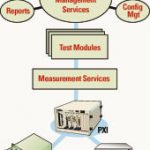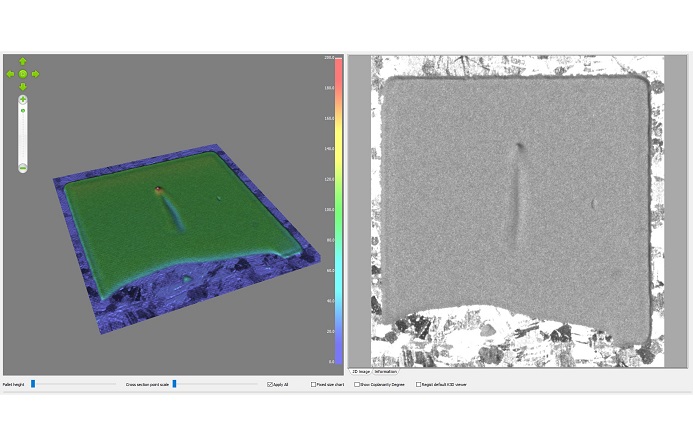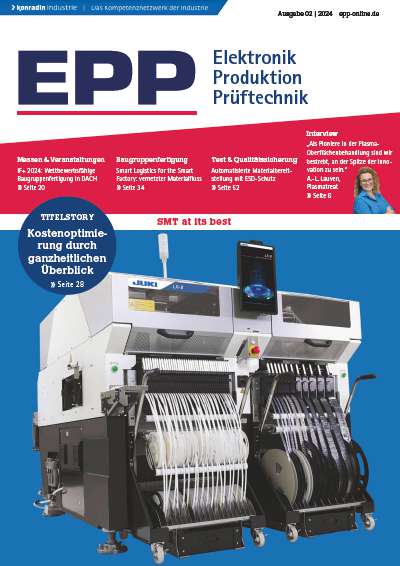In a slowing economic climate, production test faces increasing challenges brought on by lower margins, increased competition through freed manufacturing capacities, and diminishing capabilities of existing systems. Due to the overall impact, the test environment can affect a company’s bottom line. However, with a scalable architecture, based on the PXI standard, users can address many of these issues.
Richard L. McDonell, National Instruments, Austin, TX
Significant challenges have recently come about by increased competition in the manufacturing area, causing constantly decreasing time-to-market and eroding margins. As companies strive to release their products faster, there is less time for the preparation of manufacturing and test. Despite this, the product quality is expected to remain the same or, even better, to improve. The staff for manufacturing and test must find innovative ways to assemble and to verify quality faster. In most cases, they must accomplish improvements without a budget increase. This significantly increases the challenge to do more with less, requiring a closer examination of the current test architectures and processes used.
Pressing issues of test
As companies strive to lower costs associated with manufacturing and quality assurance, an inefficient use of resources caused by maintaining multiple production and test facilities is gaining increased awareness. There are many aspects attributing to the minimized use of equipment and personnel resources. As companies go through mergers or acquisitions, adding or moving manufacturing locations respectively, they have to integrate test environments which will have to work with existing complex infrastructures that are too expensive to replace. This requires a company at each manufacturing site to install its own unique test environment that complies with the existing infrastructures. The experience and knowledge of system specialists and technicians may also vary between locations.
As a result, each site integrates its own test environment based on their knowledge and resources. This prohibits an efficient development effort across a company because fragmented test architectures make it difficult for engineers at different locations to consult with one another when installing test systems. This results in each location duplicating similar features based on different architectures rather than sharing ideas and solutions between locations. Overall, the many issues associated with having multiple manufacturing and test sites can present huge problems for the engineers responsible for installing test systems and for those managing these areas across multiple sites.
Further challenges stem from the actual test architectures used, or the lack thereof. Many of these systems are built on legacy, proprietary architectures, rather than a standard platform designed for cost-efficient routine upgrades. This makes it very difficult to scale tester up and down meeting requirements due to system limitations and the extreme costs associated with the upgrades. Companies then are unable to easily upgrade their systems, and face significantly increased maintenance and support costs because many configurations use outdated software, as well as hardware that cannot provide the power and flexibility of today’s gear.
Focus on improved architecture
With the growing number of challenges, the question of what approach should be used to overcome them still remains. On the surface, it appears that the system integrators could upgrade testers individually to answer these demands. However, this approach only solves some of the issues, and inevitably requires additional patches in the short term. To truly resolve the significant requirements, companies need to focus on improving the underlying test architectures. By using modern cost-effective technology, companies can establish an environment based on scalable production test architecture that maximizes the use of their resources and provides flexibility for additional resources in the future.
Based on a scalable architecture, companies can establish a common underlying standard; while maintaining flexibility for each location to satisfy specific needs. In order to achieve this level of scalability, users must take a closer look at the elements that are valid for it. Because those configurations may include a variety of elements, test system integrators must establish a common ground when discussing the modules of a scalable architecture.
The diagram (figure 1) illustrates a typical middle-sized manufacturing line with the acquainted test and rework area. Depending on demand, it would also includean enterprise resource planning system (ERP), manufacturing execution system (MES), man-machine interface/supervisory control, data acquisition system (HMI/SCADA) and a test management system.
Because the structures of ERP, MES and HMI/SCADA arrangements are in many cases difficult to change, the test management system becomes the integral element of scalability. In non-scalable configurations, the relative, yet distant, equivalent of the test management system is a test executive. A main reason why these are not scalable is because the test executive was not designed to perform test management, but rather as a low-level sequencer to purely execute tests and return pass/fail status. For this reason, system integrators have not viewed test executives as an integral part of an architecture that could provide the scalability required between the actual testing of products and the high-level enterprise systems. With the increasing desire to create a scalable architecture, integrators are beginning to replace test executives with test management systems that fulfill a much larger role in the test architecture.
By using it, integrators can more easily adapt the systems to changing needs. Since the structure of internal systems and databases are typically predefined within an organization, they will hardly be changed for test purpose only. In addition, the type of measurements and the equipment used are described by the requirements. Therefore, the test management system is the only major element that has the ability to change and evolve. As a flexible constituent, it can act as the spine that provides the ability to ad-just from both ends to meet the overall needs.
Basic ingredients oftest management
In order for the test management system to play such an integral part in a scalable architecture, this element must also be very flexible. The block diagram (figure 2) illustrates the four basic ingredients: the test management services, test/code modules, measurement services and the PXI-controlled instruments.
The role of the test management services is to perform as an advanced and powerful test executive providing direct communication with the enterprise databases and with ERP, MES and HMI/SCADA. The test executive side of this tool provides excellent scalability of the measurement and instrumentation requirements of the test system. This is accomplished by providing the ability to call tests that are written in a wide variety of popular and legacy programming languages. The product tests are referred to as code modules. The test management service takes care of the common test executive tasks such as UUT tracking, branching, result collection, report generation and database logging. The code can be written in a modular form that only pertains to the actual test rather than requiring additional code to be included that is specific to a test executive. These modular tests act as building blocks in a sequence and promote code sharing and reuse within the company.
Further scalability is incorporated into the test management system via the measurement services that the test modules use to communicate with the hardware. Driver technologies, such as Interchangeable Virtual Instruments (IVI), add the flexibility to easily swap out similar instruments in the system without having to modify any test code. The PCI eXtensions for Instrumentation (PXI)-based hardware provides increased scalability with its ability to simplify and speed up the design of complex applications, with built-in timing and triggering in addition to its compact size and lower cost. This hardware is also designed to seamlessly communicate with VXI and GPIB-interfaced instruments.
Other benefits ofscalability
Using scalable test architecture can provide immediate as well as long- term benefits. A significant benefit is the ability to incorporate global standardization. Local integration is achieved because the test management system is flexible enough to integrate with the predefined elements on each end of the architecture. This feature is very valuable because it provides the potential of design anywhere/build anywhere. With this capability, users can easily integrate or move systems without having to entirely rebuild the tester to meet the needs of each lo-cation, and it provides significant cost reduction.
Another benefit is the modularity increase within the system. With this, test developers focus more on creating the actual tests rather than building test executives. The modular tests and sequences are more reusable and sharable within a company, as well. This saves substantial amounts of time and cost, and provides test engineers with value-added work, rather than forcing them to use their time maintaining outdated systems.
In most cases, by using a test management system, companies can significantly increase their manufacturing throughput due to the powerful multi-UUT capabilities. Other additional features, such as intelligent decision-making, make this architecture very efficient for high-mix testing. National Instruments TestStand is an example that is designed to provide these capabilities. Some of these features are illustrated in the screenshot, figure 3, showing a user interface that is controlling functional tests on multiple mobile phones at once.
EPP 179
Zusammenfassung
Qualitätssicherung in der Baugruppen-Fertigung mit elektrischen Tests zur Funktionskontrolle muß sein. Wichtig sind hier skalierbare Systeme, leicht zu modifizieren. Wobei es hilfreich ist, wenn sich einmal geschriebener Programmcode auch in ähnlichen Applikationen leicht wiederverwenden läßt. Unternehmen können damit einen soliden und kostengünstigen Standard für Prüfabteilungen an unterschiedlcihen Standorten etablieren.
Résumé
L’assurance qualité dans la fabrication de modules et les tests électriques de contrôle fonctionnel sont une nécessité. Il est important de disposer de systèmes adaptables et modifiables facilement. Il est utile également qu’un code de programme créé puisse être réutilisé aisément dans d’autres applications similaires. Les entreprises ont alors la possibilité d’établir un standard solide et économique pour les services de contrôle en différents sites.
Sommario
L’assicurazione della qualità nella produzione di gruppi costruttivi con test elettrici per il controllo di funzionamento é ormai obbligatoria. Un importante ruolo viene rivestito da sistemi scalabili, semplici da modificare, in cui però sia possibile riutilizzare i codici di programma già scritti in precedenza per applicazioni di tipo simile. Le aziende sono così in grado di stabilire uno standard solido ed economico per i propri reparti di controllo in differenti stabilimenti.
Unsere Webinar-Empfehlung
Applikationen aus dem Bereich der Leistungselektronik gewinnen immer mehr an Bedeutung. Die Inspektion dieser Applikation lässt sich mit der bewährten Standardtechnologie der 3D-Messtechnik bewerkstelligen.
Teilen:













